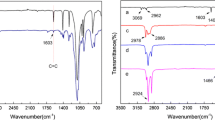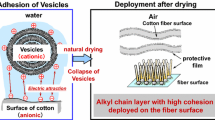Abstract
Partial cotton esters of long chain fatty acids of low degrees of substitution (D.S.<0.20) have been prepared by a variety of methods. In particular, the effects of the introduction of a stearoyl or an oleoyl group into the cellulose matrix on fabric properties, such as softness of hand and wrinkle recovery, have been studied. Attempts have been made to compare fabric properties of partial esters of like D.S. prepared by various methods of esterification and effect of a chemically attached alkanoyl group with effect of the same group deposited or adsorbed on the surface of the cotton fabric. Consideration has been given to the size of the alkyl group, its orientation on the surface of the fiber and its hydrophobicity. Data indicate that resistance to abtasion of cottons chemically modified with long chain alkyl groups is reduced whenever the finished fabric has high dry wrinkle recovery. High dry wrinkle recovery is obtained after esterification of cotton in nonaqueous media. Improvement in resistance to abrasion is pronounced when the alkyl group has not been chemically combined with the cellulose matrix in the absence of water, and usually is obtained when the finished cottons possess only high wet wrinkle recovery.
Similar content being viewed by others
References
Sexsmith, F.H., and H.J. White, Jr., J. Colloid Sci. 14:598–619 (1959).
Sexsmith, F.H., and H.J. White, Jr., Ibid. 14:630–639 (1959).
Fava, A., and H. Eyring, J. Phys. Chem. 60:890–898 (1956).
Evans, H.C., J. Colloid Sci. 13:537–552 (1958).
Matschat, K. Text. Rundsch. 16:580–585 (1961).
McKelvey, J.B., R.R. Benerito and R.J. Berni, Text. Res. J. 35:365–376 (1965).
Steele, R., Amer. Dyest. Rep. 54:6–12 (1965).
McKelvey, J.B., R.R. Benerito, R.J. Berni and J.A. O’Connor, Text. Res. J. 36:828–837 (1966).
Chipalkatti, V.C., R.M. Desai, N.B. Sattur, J.V. Varghese and J.C. Patel, Ibid. 33:282–295 (1963).
Chipalkatti, V.C., Ibid. 35:1049–1051 (1965); Ibid. Text. Res. J. 37:242–253 (1967).
Chipalkatti, V.B., R.M. Desai, N.B. Sattur and I. Hussain, British Patent 1,106,178 (1968).
Berni, R.J., J.B. McKelvey and R.R. Benerito, Text. Res. J. 37:706–707 (1967).
Karrer, P. (to Heberlein and Co.), U.S. Patent 1,897,026 (1933).
Benerito, R.R., R.J. Berni and J.B. McKelvey, Read before the 157th National Meeting of the American Chemical Society, Minneapolis, April 1969.
Schwenker, R.F., and E. Pacsu, Tappi 46:665–672 (1963).
Avny, Y., and L. Rebenfeld, Text. Res. J. 38:599–605 (1968).
American Society Testing Materials, Designations: (a) D1682-64; (b) D1175-64T; (c) D2654-67T; (d) 1295-67.
Fujimoto, R.A., R.M. Reinhardt and J.D. Reid, Amer. Dyest. Rep. 52:329–336 (1963).
Berni, R.J., D.M. Soignet and T.L. Ward, Text. Res. J. 39:887–889 (1969).
Cannizzaro, A.M., W.R. Goynes, M.L. Rollins and R.J. Berni, Ibid. 38:842–854 (1968).
Whitby, G. S., J. Chem. Soc. 1926:1458–1465.
Paul, R., Bull. Soc. Chim. France Ser. 5 1:971–981 (1934).
AATCC Northern New England Section. Amer. Dyest Rep. 55:43–48 (1966).
Hess, K., and C.Z. Trogus, Z. Physik. Chem B 15:157–222 (1931).
Sisson, W.A., Ind. Eng. Chem. 30:530–537 (1938).
Freeman, I.P., and I.D. Morton, J. Chem. Soc. (C) 1966:1710–1711.
Dobinson, B., A.J. Duke, K.W. Humphreys, E. Johnston, R.J. Martin, L.S.A. Smith and B.P. Stark, Makromol. Chem. 59:82–105 (1963).
Parham, W.E., and E.L. Anderson, J. Amer. Chem. Soc. 70:4187–4189 (1948).
Ottewill, R.H., and J.M. Tiffany, J. Oil Colloid Chem. Ass. 50:844–864 (1967).
Deanin, R.D., and D.C. Patel, Read before the 159th National Meeting of the American Chemical Society, Houston, February 1970.
Author information
Authors and Affiliations
Additional information
One of eight papers being published from the Symposium “Surface Active Agents in the Textile Industry,” presented at the AOCS Meeting, New Orleans, April 1970.
So. Utiliz. Res. Dev. Div., ARS, USDA.
About this article
Cite this article
Benerito, R.R., McKelvey, J.B. & Berni, R.J. Built-in lubrication on cotton fabrics. J Am Oil Chem Soc 48, 284–290 (1971). https://doi.org/10.1007/BF02638463
Received:
Issue Date:
DOI: https://doi.org/10.1007/BF02638463




